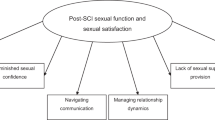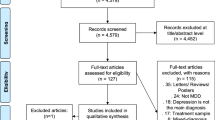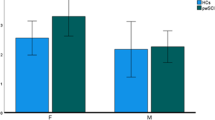Abstract
Study design
Systematic review.
Objectives
To create an overview of standardized assessments to evaluate sexuality after SCI/D in a systematic literature review. Furthermore, we explored the various dimensions of sexuality assessed by these tools and analyzed sex and gender differences.
Methods
In a systematic review (PROSPERO CRD42023416855), we reviewed published assessments of sexuality in individuals with SCI/D with a focus on differences between women and men. The comprehensive search was conducted in PUBMED, Medline, CINAHL and psychINFO in March 2023. The extracted publications were grouped and analyzed according to their objectives.
Results
A total of 264 papers were included in the analysis and divided into three categories: “physiological aspects of sexuality”, “psychological aspects of sexuality”, and “sexual adjustment”. Most assessments of sexuality after SCI/D concern physiological aspects (n = 176, 66.7%). Fewer studies focus on psychological aspects (n = 49, 18.6%), and sexual adjustment (n = 39, 14.8%) is the least investigated topic. More research has been published on men’s compared to women’s sexuality (n = 195, 73.9% versus n = 125, 47.3%). In men, the most frequently used standardized assessment is the International Index for Erectile Function (IIEF). In women, the equivalent to the IIEF, the Female Sexual Function Index (FSFI), is most frequently used.
Conclusion
Most assessments focus primarily on sexual function in men. New assessments are needed to address other aspects of sexuality as well. Furthermore, more research on female sexuality is needed.

Sexual function is the most commonly investigated aspect of sexuality in individuals with spinal cord injury or disease – a systematic review
This is a preview of subscription content, access via your institution
Access options
Subscribe to this journal
Receive 12 print issues and online access
$259.00 per year
only $21.58 per issue
Buy this article
- Purchase on SpringerLink
- Instant access to full article PDF
Prices may be subject to local taxes which are calculated during checkout

Similar content being viewed by others
Data availability
The generated and analyzed datasets are available from the corresponding author on reasonable request.
References
Calabro RS, Cacciola A, Bruschetta D, Milardi D, Quattrini F, Sciarrone F, et al. Neuroanatomy and function of human sexual behavior: a neglected or unknown issue? Brain Behav. 2019;9:e01389.
Hess MJ, Hough S. Impact of spinal cord injury on sexuality: broad-based clinical practice intervention and practical application. J Spinal Cord Med. 2012;35:211–8.
Anderson KD, Borisoff JF, Johnson RD, Stiens SA, Elliott SL. The impact of spinal cord injury on sexual function: concerns of the general population. Spinal Cord. 2006;45:328–37.
Sipski ML, Alexander CJ, Rosen RC. Physiological parameters associated with psychogenic sexual arousal in women with complete spinal cord injuries. Arch Phys Med Rehabil. 1995;76:811–8.
Previnaire JG, Soler JM, Alexander MS, Courtois F, Elliott S, McLain A. Prediction of sexual function following spinal cord injury: a case series. Spinal Cord Ser Cases. 2017;3:17096.
Krassioukov A, Elliott S. Neural control and physiology of sexual function: effect of spinal cord injury. Top Spinal Cord Inj Rehabil. 2017;23:1–10.
Barrett OEC, Mattacola E, Finlay KA. “You feel a bit unsexy sometimes”: the psychosocial impact of a spinal cord injury on sexual function and sexual satisfaction. Spinal Cord. 2022;61:51–6.
Anderson KD. Targeting recovery: priorities of the spinal cord-injured population. J Neurotrauma. 2004;21:1371–83.
Tricco AC, Lillie E, Zarin W, O’Brien KK, Colquhoun H, Levac D, et al. PRISMA extension for scoping reviews (PRISMA-ScR): checklist and explanation. Ann Intern Med. 2018;169:467–73.
Rosen RC, Riley A, Wagner G, Osterloh IH, Kirkpatrick J, Mishra A. The international index of erectile function (IIEF): a multidimensional scale for assessment of erectile dysfunction. Urology. 1997;6:822–30.
Rosen R, Brown C, Heiman J, Leiblum S, Meston C, Shabsigh R, et al. The female sexual function index (FSFI): a multidimensional self-report instrument for the assessment of female sexual function. J Sex Marital Ther. 2000;26:191–208.
Derogatis LR, Melisaratos N. The DSFI: a multidimensional measure of sexual functioning. J Sex Marital Ther. 1979;5:244–81.
Sipski ML, Alexander CJ. Sexual activities, response and satisfaction in women pre- and post-spinal cord injury. Arch Phys Med Rehabil. 1993;74:1025–9.
White MJ, Rintala DH, Hart KA, Fuhrer MJ. Sexual activities, concerns and interests of women with spinal cord injury living in the community. Am J Phys Med Rehabil. 1993;72:372–8.
Merghati-Khoei E, Maasoumi R, Rahdari F, Bayat A, Hajmirzaei S, Lotfi S, et al. Psychometric properties of the Sexual Adjustment Questionnaire (SAQ) in the Iranian population with spinal cord injury. Spinal Cord. 2015;53:807–10.
Giuliano F, Rubio-Aurioles E, Kennelly M, Montorsi F, Kim ED, Finkbeiner AE, et al. Vardenafil improves ejaculation success rates and self-confidence in men with erectile dysfunction due to spinal cord injury. Spine (Phila Pa 1976). 2008;33:709–15.
Merghati-Khoei E, Emami-Razavi SH, Bakhtiyari M, Lamyian M, Hajmirzaei S, Ton-Tab Haghighi S, et al. Spinal cord injury and women’s sexual life: case-control study. Spinal Cord. 2017;55:269–73.
Tzanos I-A, Tzitzika M, Nianiarou M, Konstantinidis C. Sexual dysfunction in women with spinal cord injury living in Greece. Spinal Cord Ser Cases. 2021;7:41.
Khak M, Hassanijirdehi M, Afshari-Mirak S, Holakouie-Naieni K, Saadat S, Taheri T, et al. Evaluation of sexual function and its contributing factors in men with spinal cord injury using a self-administered questionnaire. Am J Mens Health. 2014;10:24–31.
Schmid DM, Schurch B, Hauri D. Sildenafil in the treatment of sexual dysfunction in spinal cord-injured male patients. Eur Urol. 2000;38:184–93.
Soler JM, Previnaire JG, Denys P, Chartier-Kastler E. Phosphodiesterase inhibitors in the treatment of erectile dysfunction in spinal cord-injured men. Spinal Cord. 2007;45:169–73.
Sipski M, Alexander CJ, Gómez-Marín O. Effects of level and degree of spinal cord injury on male orgasm. Spinal Cord. 2006;44:798–804.
Gomes CM, Miranda EP, de Bessa J Jr, Bellucci CHS, Battistella LR, Abdo CHN, et al. Erectile function predicts sexual satisfaction in men with spinal cord injury. Sex Med. 2017;5:e148–e55.
Reitz A, Tobe V, Knapp PA, Schurch B. Impact of spinal cord injury on sexual health and quality of life. Int J Impot Res. 2004;16:167–74.
Miranda EP, Gomes CM, de Bessa J Jr, Najjar Abdo CH, Suzuki Bellucci CH, de Castro Filho JE, et al. Evaluation of sexual dysfunction in men with spinal cord injury using the male sexual quotient. Arch Phys Med Rehabil. 2016;97:947–52.
Hultling C, Giuliano F, Quirk F, Peña B, Mishra A, Smith MD. Quality of life in patients with spinal cord injury receiving Viagra (sildenafil citrate) for the treatment of erectile dysfunction. Spinal Cord. 2000;38:363–70.
Mona LR, Krause JS, Norris FH, Cameron RP, Kalichman SC, Lesondak LM. Sexual expression following spinal cord injury. NeuroRehabilitation. 2000;15:121–31.
Raguindin PF, Muka T, Glisic M. Sex and gender gap in spinal cord injury research: focus on cardiometabolic diseases. A mini review. Maturitas. 2021;147:14–8.
Burns SM, Hough S, Boyd BL, Hill J. Sexual desire and depression following spinal cord injury: masculine sexual prowess as a moderator. Sex Roles: J of Res. 2009;61:120–9.
Sipski ML, Alexander CJ, Rosen RC. Orgasm in women with spinal cord injuries: a laboratory-based assessment. Arch Phys Med Rehabil. 1995;76:1097–102.
Celik EC, Akman Y, Kose P, Arioglu P, Karatas M, Erhan B. Sexual problems of women with spinal cord injury in Turkey. Spinal Cord. 2014;52:313–5.
Zarei F, Rashedi S, Tavousi M, Haeri-Mehrizi AA, Maasoumi R. A mobile-based educational intervention on sexo-marital life in Iranian men with spinal cord injury: a randomized controlled trial. Spinal Cord. 2020;58:1189–96.
Funding
Swiss Paraplegic Research.
Author information
Authors and Affiliations
Contributions
JLM: study conception and design of systematic review, developed the review protocol, literature search, data extraction, and analysis. Wrote and revised the manuscript. Approval of final version. JJWvB: screening and extraction of data, critical editing of manuscript, approval of final version. JW: study conception, resolution of disagreements in screening process, critical editing of manuscript, approval of final version. JK: study conception and design, screening of data, supervision, assisted with interpretation of data, critical editing of manuscript, approval of final version. JP: study conception and design, supervision, assisted with interpretation of data, provided clinical expertise, critical editing of manuscript, approval of final version.
Corresponding author
Ethics declarations
Competing interests
The authors declare no competing interests.
Additional information
Publisher’s note Springer Nature remains neutral with regard to jurisdictional claims in published maps and institutional affiliations.
Attribution of work: Swiss Paraplegic Research, Nottwil, Switzerland.
Supplementary information
Rights and permissions
Springer Nature or its licensor (e.g. a society or other partner) holds exclusive rights to this article under a publishing agreement with the author(s) or other rightsholder(s); author self-archiving of the accepted manuscript version of this article is solely governed by the terms of such publishing agreement and applicable law.
About this article
Cite this article
Mahler, J.L., van Beek, J.J.W., Wöllner, J. et al. Sexual function is the most commonly investigated aspect of sexuality in individuals with spinal cord injury or disease – a systematic review. Spinal Cord 63, 523–529 (2025). https://doi.org/10.1038/s41393-025-01111-y
Received:
Revised:
Accepted:
Published:
Issue date:
DOI: https://doi.org/10.1038/s41393-025-01111-y



